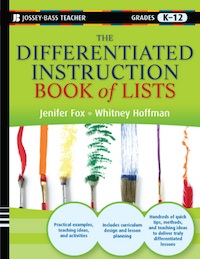Apr 29, 2011 by Whitney Hoffman
Yesterday, I was at a meeting where a typical “mexican stand-off” began to take place. One group wanted a group of teachers to receive professional development for a technology only a small portion of them had access to, and were insisting the PD had to take place first; in the mean time, the teacher-learners were saying, quite reasonably, that they weren’t eager to take a course for something they wouldn’t have an opportunity to implement, and if it was eventually implemented, the knowledge they acquired in the PD would be long enough ago to make it useless and it would need to be redone.
These sorts of arguments take place all the time. Each side has it’s points that are perfectly reasonable on the face. However, in education, we seem not to want to spend money or adopt a technology until we can be 100% assured of its eager acceptance, use and return on investment. What drives me insane is that teachers and educators, out of everyone else in society all together, have first hand knowledge of something called the learning curve.
The learning curve, as you all know, is the process of trying and experimenting with learning new skills and acquiring information. It may take many repetitions, experimentation and tweeks before people feel masterful with any new piece of information. We have yet to develop a pill or two hour course that can guarantee to make a kid read- the process of learning to walk, read, ride a bike, etc. all takes a number of trials, making mistakes, and eventually reaching mastery.
Yet it seems like some adults forget this completely when it comes to expecting instant results from adding things like computers, tablets or smart boards in the classroom. In even the best of circumstances with flawless and epic professional development, teachers will still have to adapt any new tool- a textbook, a worksheet or a computer, ELMO or Smart Board into their lesson plan and curriculum. Heck, every year they have to adapt their current lesson plans to a whole new group of students who come in, not as widgets down an assembly line, but as a whole new group and community that needs to be transformed into a community of learners. Those lessons and plans will need to be tweeked along the way as the teacher gets to know the students- and no amount of prior knowledge makes that problem go away. Experience does make the process faster, as a seasoned teacher can spot patterns they’ve seen before and may have more tools readily available to pull out when needed. But regardless, in September, there is annually an adjustment period for everyone, teacher and student alike, as each learn about the other on a standard learning curve.
No one can reasonably and 100% guarantee that any new technology or curriculum or ANYTHING at all will be 100% successful in the classroom in advance. We can say that others have had good experiences, and that support can be provided, but that in the end, teachers will have to learn about the new tools by using and experimenting with them to find out what works best for them.
If we want to solve these sorts of issues, I think it’s time to consider whether we need to equally apply the principals of Differentiating Instruction, Personalized and Project based learning to professional development.
Maybe teachers have to devise, along with other teachers in their school or grade, true professional learning communities. Not everyone will have the same level of experience and expertise, but they can help each other. What is a group decided to set a few goals in the beginning of the year- a project- such as adapting 3 or 4 units in order to incorporate new technology tools ranging from smart boards to wikis and blogs? What if they set a goal to make sure every classroom at a certain grade level had its own web page for communicating information with students and parents? This would be a tangible, useful goal to set, making sure not only that teachers had something to show for their PD at the end, but that they also got more direct experience implementing tools in a real life setting, which helps consolidate learning, just as we recommend for kids. This makes the classroom much more of a laboratory and exploration of learning, which has the useful side effect of injecting a little more joy and risk into the equation, making it more enjoyable for teachers and students alike.
Whether we call these things Individualized Learning Plans for teachers, Professional development milestones, Project based learning for educators- it doesn’t really matter. What matters in the end is that the emphasis will be in trusting teachers to set and meet their personal and professional goals. This is probably a much better measure of teacher engagement and professional development and evaluation than looking at student test scores. What got accomplished and what did not? What additional supports are needed? What could we do to take this to the next level next year? This analysis will do more to improve teacher morale and student learning than any of the current crime and punishment like measures that are in place today.
There will always be the 16% technological laggards that still wonder what was wrong with slates and McGuffey’s Readers, and the twenty percent of people who hate anything new regardless of what it might be. In fact, every teacher knows this, because there are always one or two kids in a class who are more difficult to teach and more resistant, but we don’t refuse to teach the rest of the students because these kids aren’t on board- that would be silly. We wouldn’t stop teaching if one kid was absent. So why is this an issue for adults?
We simply can no longer afford to wait for 100% compliance or 100% agreement to move forward. If we waited for everyone to be on board before doing something, we never would have gotten out of the plains in Africa, and would still be wondering whether this new found “fire” thing was really advised or was simply too dangerous to be reasonably contained and adopted as a fuel source. (Ok, that was a little snarky, sorry.) Seriously though, we have to start taking chances as professionals and be willing to learn and experiment, the same way we expect students to do every day. Unless we adopt this attitude of going forward and be willing to work things out, we’ll never make the progress teachers and students both deserve.





